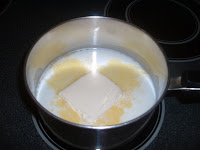
Potatoes and fish seem to be good friends since they've been known to socialize in many dishes. Patate con Baccala, more commonly known to most as Potatoes and Cod are no exception.
This pair is frequently seen enjoying each others company in a delicious pool of tomato sauce surrounded by tasty aromatics and some hearty, crusty bread close by.
My childhood recollection of this dish include one or more weeks of seeing this wooden looking piece of dried fish soaking in a bowl of cold water. A daily change of fresh water would eventually wash away the saltiness and put enough life back into the fish to make it ready for cooking.
My husband’s memories however are a little different.
He recalls being sent by his mother to the local vendor to buy 250 grams of baccala to be cooked for dinner that evening. This cod would have been already re-hydrated by the store keeper and ready for cooking.
He would eventually get home with a whole lot less than the original amount he started out with.
It was a good thing she didn’t ask him to buy the potatoes since he’s the only person I know that also enjoys eating raw potatoes!
My guess is that she hid the potatoes anticipating having to compensate for the missing fish and still be able to make a meal out of what eventually made it home.
We are living in such a time of abundance. There's presently a piece of dried cod weighing just over two pounds sitting in my fridge waiting to be re-hydrated.
I admit, the thought of having to baby sit this piece of fish for days until it’s ready to cook makes me postpone having it on the dinner menu. I do however eventually get around to it with a tasty reward I might add.
You may be interested to know that I’ve been known to substitute fresh or frozen cod for the baccala. Even though the results take second place it's also absolutely delicious.
All these memories and writing about baccala have motivated me to give that piece I have in the fridge a good soak.
In the meantime I’m going to defrost some cod I have in the freezer and make it for dinner tonight.
Patate con Baccala
about 600 grams cod fish pieces
about 6 medium potatoes peeled and cut into 2 inch pieces
¼ cup corn oil
2 medium onions peeled and chopped
2 stalks celery, chopped
½ cup pitted Kalamata olives
zest of 1 lemon (yellow part only)
1 16 ounce can peeled plum tomatoes pureed in blender and strained
salt and pepper to taste
1 teaspoon chili flakes (optional)
- If using frozen cod, defrost and drain well in a colander.
- If using salted cod soak in fresh water making sure to change water frequently until re-hydrated (several days) then drain well.
- Place oil, celery, onion, olives and lemon zest in a large skillet and sauté until hot.
- Add potato chunks and mix into the ingredients already in the skillet.
- Add salt and pepper to taste and chili flakes if using.
- Add strained tomato puree to cover potatoes and bring up to a boil.
- Lower heat to a simmer and cook covered until the potatoes are cooked but still firm.
- Place the cod on top and spoon some of the potatoes and tomato over the fish to cover it.
- Cover skillet and let cook until the fish flakes when pierced with a fork.
- Remove lemon zest.
- Let rest 15 to 20 minutes before serving.
- Approximately 3 to 4 servings






Notes, Tips and Suggestions
- Sole and basically any thick, boneless white fish can be substituted if you don't have cod but to get a truly authentic experience salted cod would be the choice.
- Make sure to use fish pieces that are one inch or more in thickness.
- When making a larger quantity, follow recipe until potatoes are cooked in the skillet then place the raw fish into an oven proof baking pan and pour potato mixture over the fish. Cover and bake in a 375 degree F. until fish is cooked.
- When serving, garnish with chopped, fresh, Italian parsley if desired.
































